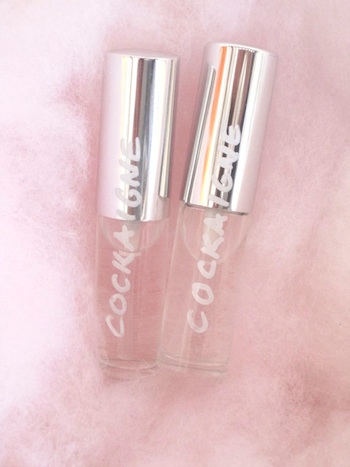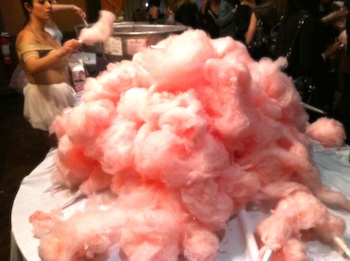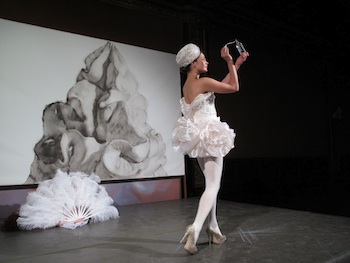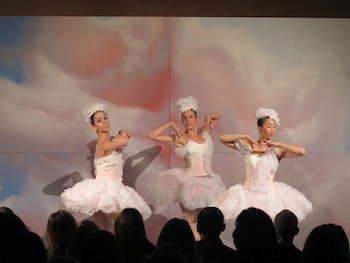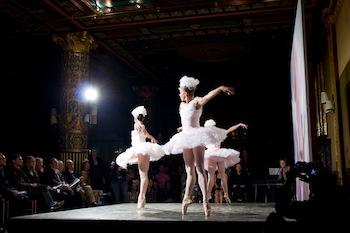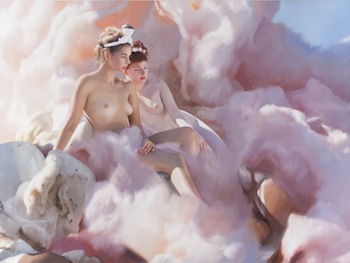
Will Cotton, "Consuming Folly," 2009-2010. Oil on linen, 72 x 96 in. Courtesy the artist and Mary Boone Gallery.
Will Cotton’s candy and pastry-filled landscapes have come to life in recent years, taking the form of a posh pop-up bakery in 2009, and a year later, forming the set of Katy Perry’s music video “California Gurls.” Cotton’s saccharine world materialized again last Friday night at New York’s Prince George Ballroom, where cotton candy took center stage in Cockaigne, the artists’s first live production.
Curated by Stacey Engman for Performa 11, on the one hand, the performance received more hype than it deserved and left some things to be desired. On the other hand, the night was strangely satisfying in that every guest was part of Cotton’s show, an immersive sensory experience that began the minute we crossed the threshold. In a sense, just being there was to become one of the artist’s painted subjects, engulfed by cotton candy in a land of pleasure and plenty.
At the entrance, Cotton’s assistants handed out complimentary bottles of the candy-scented perfume “Cockaigne,” made in collaboration with International Flavors and Fragrance leaders Nicolas Mirzayantz, Pascal Gaurin, and Maria Wright. In the venue’s main room, that sweet scent was twice as thick, thanks to two women who spun cones of pink cotton candy for guests. In proper Cotton fashion, many of his assistants wore little cotton candy fluffs on their head. A sugar haze filled the room and floating filaments seemed to bond to my eyelashes and contact lenses as I ate and licked the pink stuff from my fingers. Inside and out, I grew delightfully stickier by the minute. As if all that wasn’t enough, cupcakes and champagne could also be had.
The cocktail reception set the tone for the main event, a two-act dance performance created in collaboration with big name creatives, including choreographer Charles Askegard, formerly of New York City Ballet, and MacArthur-winning composer John Zorn. Unfortunately, the performances failed to titillate like the hoopla that lead up to them. First on stage was singer-musician Hannah Cohen (a sometimes model for Cotton, Richard Prince, Terry Richardson, and David Salle) who had the simple task of spritzing perfume, humorously pumping whipped cream fragrance in the air at every turn of her sparkly heels. She bared some resemblance to a bothersome employee of a department store perfume counter.
Burlesque personality Miss Ruby Valentine (who has also sat for Cotton’s portraits) quickly followed with a whipped cream-inspired routine, making bullfighter-like gestures with white feather fans, set to a score by Caleb Burhans. Last up was the highly anticipated and sadly underwhelming “Cotton Candy” ballet choreographed by Askegard and enacted by a trio of ballerinas: Savannah Lowery, Georgina Pazcoguin and Ana Sofia Scheller. Had it not been for their impressive professional bios and ability to dance on pointe, I might have written them off as young amateurs just happy for an audience. They appeared cramped on the small stage and their movements were so cutesy that I could hardly take them seriously. As we know, context is everything. Running for maybe ten minutes in total, when the performances were over you got the sense that the audience was waiting for more, a grand finale, a climax that never came.
Cotton is no stranger to criticism, particularly where it concerns his treatment of the female body. It is hard to know when he is critiquing desire in consumer culture or reinforcing sexual stereotypes. Cockaigne was no exception. My companions that evening expressed discomfort with the artist’s blatant objectification of women and staging of male fantasy. Should we have expected anything less? Cockaigne was, after all, a real time manifestation of Cotton’s oeuvre, where celebrities, burlesque performers, and pale-skinned nudes are dropped like candies into plush Rococoesque landscapes. As Ms. Magazine blogger Stassa Edwards writes, they are “beautifully constructed scenes in which women are presented for decoration or sexual consumption.” Perhaps, then, Cockaigne was, for right or wrong or however you want to interpret it, just as it was intended to be.
In the end, the food-inspired dances of Cockaigne were just meh, pleasant but not all that interesting, and to my friends, somewhat distasteful. But there is another way of looking at this performance: as an active eater and partaker of Cotton’s ephemeral, olfactory, and sort of carnivelsque space. In that sense, Cockaigne was a wonderfully Wonka experience and utter sugar bliss.
Cotton’s first monograph, Will Cotton: Paintings & Works on Paper, was released earlier this month. Published by Rizzoli, the book is available for purchase from Amazon.

